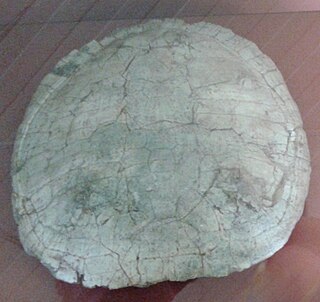
Rosellas are in a genus that consists of six species and nineteen subspecies. These colourful parrots from Australia are in the genus Platycercus. Platycercus means "broad-tailed" or "flat-tailed", reflecting a feature common to the rosellas and other members of the broad-tailed parrot tribe. Their diet is mainly seeds and fruit.
In biology, a homonym is a name for a taxon that is identical in spelling to another such name, that belongs to a different taxon.

Elmisaurus is an extinct genus of dinosaur from the Late Cretaceous. It was a theropod belonging to the Oviraptorosauria. Its fossils have been found in Mongolia. It is known from foot and hand bones.

Banksia elegans, commonly known as the elegant banksia, is a species of woody shrub that is endemic to a relatively small area of Western Australia. Reaching 4 m (13 ft) high, it is a suckering shrub that rarely reproduces by seed. The round to oval yellow flower spikes appear in spring and summer. Swiss botanist Carl Meissner described Banksia elegans in 1856. It is most closely related to the three species in the subgenus Isostylis.

Ctenochasma is a genus of Late Jurassic ctenochasmatid pterosaur belonging to the suborder Pterodactyloidea. Three species are currently recognized: C. roemeri, C. taqueti, and C. elegans. Their fossilized remains have been found in the Solnhofen Limestone of Bavaria, Germany, the "Purbeck Group" of northeastern Germany, and the Calcaires tâchetés of eastern France.

Caenorhabditis is a genus of nematodes which live in bacteria-rich environments like compost piles, decaying dead animals and rotting fruit. The name comes from Greek: caeno- ; rhabditis = rod-like. In 1900, Maupas initially named the species Rhabditis elegans, Osche placed it in the subgenus Caenorhabditis in 1952, and in 1955, Dougherty raised Caenorhabditis to the status of genus.

Cyclanorbis is a genus of softshell turtles in the family Trionychidae. The genus is endemic to Africa.

The elegant water shrew is a species of mammal in the subfamily Soricinae of the family Soricidae. It is monotypic within the genus Nectogale. It lives in Sikkim and China.

Eudromia is a genus of birds in the tinamou family. This genus comprises two crested members of this South American family.

The false ark shells (Cucullaea) are a small genus of marine bivalve molluscs related to the ark clams. The genus is the only member of the family Cucullaeidae.
Platycraniellus is an extinct genus of non-mammalian cynodonts. It is known from the Early Triassic Lystrosaurus Assemblage Zone of the Normandien Formation of South Africa. The type and only species is P. elegans.
Camarotoechia is an extinct genus of brachiopods found in Paleozoic strata.
Calliscelio is a parasitoid wasp monotypic genus which contains one species, C. elegans. It was first described as Caloteleia elegans on Oahu in the Hawaiian Islands in 1910 by British entomologist Robert Cyril Layton Perkins, who believed it not to be an indigenous species of Hawaii. Its pantropical species distribution is now well-established and it is still considered to be an adventive species in Hawaii. C. elegans was reassigned from its original genus to Caenoteleia in 1926 by French entomologist Jean-Jacques Kieffer and then to Calliscelio in 2009.
Bohemiatupus is an extinct genus of griffenfly in the family Meganeuridae and containing a single species Bohemiatupus elegans. The species is known only from the Late Carboniferous, Bolsovian stage, Kladno Formation near the village of Radnice in the Radnice Basin, Czech Republic.
Dynoides elegans is a species of isopod crustacean in the genus Dynoides. It was originally described in 1923 by Pearl Lee Boone as "Cianella elegans" based on specimens from La Jolla and San Pedro, California. It was transferred to the genus Dynoides in 2000, when Boone's genus was sunk into synonymy with Dynoides.

Apophysomyces variabilis is an emerging fungal pathogen that can cause serious and sometimes fatal infection in humans. This fungus is a soil-dwelling saprobe with tropical to subtropical distribution. It is a zygomycete that causes mucormycosis, an infection in humans brought about by fungi in the order Mucorales. Infectious cases have been reported globally in locations including the Americas, Southeast Asia, India, and Australia. Apophysomyces variabilis infections are not transmissible from person to person.
Acropora elegans is a species of acroporid coral that was first described by Henri Milne-Edwards in 1860. Found in sheltered, sloping reefs, this species occurs at 30 to 60 m depth. The species is listed as vulnerable on the IUCN Red List, and has a decreasing population. It is not common and has a small range, and is listed under CITES Appendix II. It is more resistant to disease than other Acropora species.

Bauruemys is an extinct genus of turtles in the family Podocnemididae.

Citipes is an extinct genus of caenagnathid dinosaurs known from the Late Cretaceous Dinosaur Park of southern Alberta, Canada. It lived about 76.9–75.8 million years ago. The specializations of the beak in Citipes and other caenagnathids suggest that they were herbivores. The type species, C. elegans had been previously placed within the genera Chirostenotes, Elmisaurus, Leptorhynchos and Ornithomimus.











